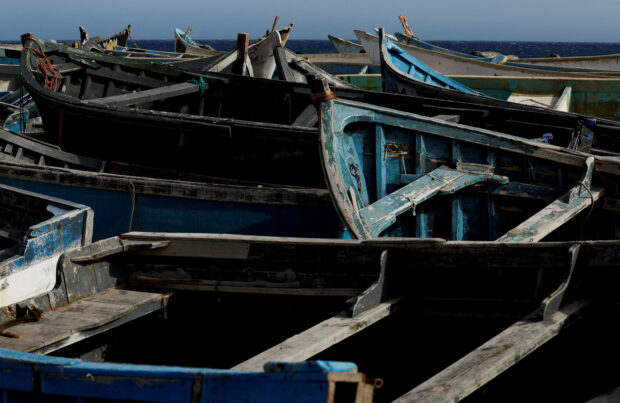More than 30 feared dead as dinghy bound for Spain’s Canary Islands sinks

Dozens of wooden boats used by migrants to reach the Canary Islands are seen at the Port of Arinaga, in the island of Gran Canaria, Spain, June 7, 2022. Picture taken June 7, 2022. REUTERS FILE PHOTO
MADRID — More than 30 migrants were feared dead after a dinghy headed for Spain’s Canary Islands sank on Wednesday, two migration-focused organizations said, as they criticized Spain and Morocco for not intervening earlier to rescue the vessel’s passengers.
The groups, Walking Borders and Alarm Phone, said the dinghy was originally carrying around 60 people. Spain’s maritime rescue service confirmed the deaths of two of the dinghy’s occupants, a child and an adult man, and said a Moroccan patrol boat had previously rescued 24 people.
Neither Spanish nor Moroccan authorities would confirm how many people had been on board the vessel or how many might be missing.
Walking Borders spokesperson Helena Maleno said in a tweet that 39 people had drowned, without giving further details, while Alarm Phone, which operates a trans-European network supporting rescue operations, said 35 people were missing.
The tragedy sparked criticism from migrant rights activists who accused Spain of omitting its duty of care, as the dinghy was within the country’s search-and-rescue region under international law, meaning Madrid should have led the operation instead of Rabat.
At the time of its sinking, the dinghy was located in waters off the coast of Western Sahara. Although Morocco administers a majority of the former Spanish colony, its sovereignty remains under dispute and the United Nations lists it as a non-self governing territory.
Spain’s state news agency EFE reported that a Spanish rescue service ship, the Guardamar Caliope, was only 46 km (26 miles) – about an hour’s sail – away from the dinghy on Tuesday evening.
The Guardamar Caliope did not aid the dinghy because the operation had been taken over by the Moroccan Rescue Coordination Centre in Rabat, which dispatched a patrol boat that only arrived on Wednesday morning, some 10 hours after it had been spotted by a Spanish rescue airplane, EFE added.
“It’s torture to have 60 people, including six women and a baby, waiting for more than 12 hours for a rescue in a flimsy inflatable boat that can sink,” Walking Borders’ Maleno said.
“Spain has pulled a Greece,” she wrote in another tweet, in reference to the recent shipwreck off Greece’s Mediterranean coast in which at least 82 people drowned, while describing Europe’s border policies as “torture and death”.
The EU has said it and member states have been intensifying efforts to establish an “effective, humanitarian and safe” European migration policy.
Morocco’s Interior ministry has not responded to a Reuters request for comment and Morocco has not made any official communication about what happened.
The leader of the Canary Islands region, Angel Victor Torres, lamented the deaths on Twitter and said it was “necessary and urgent for the EU to have a Migration and Asylum Pact that offers coordinated and united responses to the migration phenomenon”.
The Canary Islands off the coast of West Africa have become the main destination for migrants trying to reach Spain, with a much smaller share trying to cross the Mediterranean Sea to the Spanish mainland.
The Atlantic migration route is one of the deadliest in the world. Attempts to reach the Canary Islands’ shores saw at least 559 people – including 22 children – die in 2022, according to data from the U.N.’s International Organisation for Migration.
The migrants using the route are typically from several countries in Sub-Saharan Africa.
RELATED STORIES